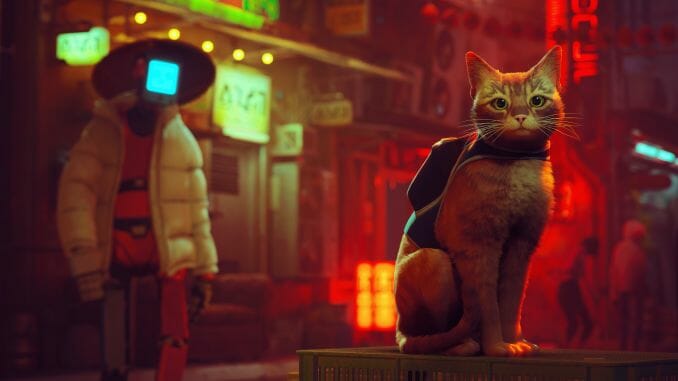Stray Is More Than Just “The Cat Game”

Stray is the cat game. If you pay attention to games you’ve heard about the cat game—the game where you play as a cat. It’s not like the goose game, where you’re an asshole to people, or the goat game, where, uh, you’re an asshole to people, even if cats are nature’s most lovable and snuggleable assholes. No, this generally well-meaning cat has to navigate a post-apocalyptic underground city populated by the robotic helpers left behind after climate devastation and a pandemic destroyed humanity years earlier, and you get to help it. Congrats.
Stray absolutely understands what it’s like to be a cat—at least from a human’s perspective. This cat will scratch on rugs, walls, and furniture. This cat will nonchalantly knock glasses, vases, and even open cans of paint off shelves. This cat will get its head stuck in paper bags, hang out in empty boxes, or idly swat balls back and forth, if you want it to. This cat will even jump onto a table in the middle of a game of dominoes, knocking the pieces all over the floor. It’ll also purr and meow, rub itself lovingly against the legs of those it likes, and even snuggle up against a robot as it takes a nap. Stray captures the mischief, aloofness, and sweetness of a cat, while also uncannily recreating the way they look and move.
Stray’s first few minutes feel like a revelation. Your cat and a few of its fellow strays strut about some overgrown industrial site, just being cats. There’s no clear motivation, no clear goals, just curiosity and the joy of movement. The promise of an open-ended cat exploration game is palpably exciting. Obviously this game is going to have to become a game, though, so as the tutorial ends your kitty is separated from its clowder, introduced to fearful robots (who are, themselves, strays) who need the help of a (very small, very furry) stranger just like you, and Stray starts to introduce its sad yet hopeful themes. And since a cat will need some way to interact and communicate with the world around it, Stray quickly teams your little buddy up with its own little buddy: B-12, a small drone with a big brain and a bad memory. B-12 is navigator, translator, hacker, weapon, flashlight, and more, all in one—and with a mystery that becomes crucial to Stray’s story.
Although you play as a cat, there’s no way to really play like a cat. We can’t really think like a cat, and technology has not advanced to the point where we can play videogames without the use of our own human thoughts and emotions. Add in the talkative helper, the meeting and greeting of every robot who doesn’t try to kill you, and the quid pro quo quests, and you have a fairly traditional adventure game despite its unique hero. Once that realization settles in, and you’re in the middle of doing a favor for a robot so he can give you the whatsis you need to do a favor for ANOTHER robot, you might have a hard time remembering the excitement of that tutorial.
The emotional stakes continue to increase, though. You learn more about your drone friend and how it came to get its personality. You get deeper and deeper into the world these robots live in, and what happened to make it this way. You start to care, not just about yourself or your buddy, but about the robots you meet along the way, from the ones who’ve spent years trying to break out of their mundane lives, to those who are just happy getting by where they are. Stray works not because of its lovable cat hero, but because it makes you care about its story, both through the fiction it creates and the real-world facts it evokes.